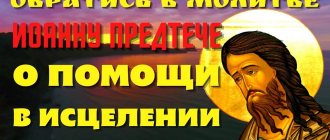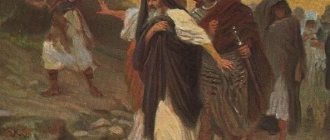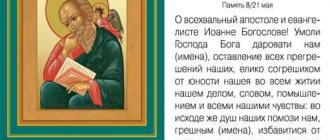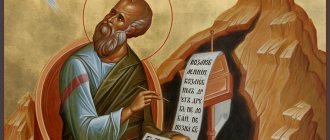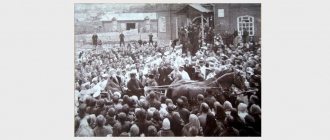Prayer to John the Baptist for healing
The image of John the Baptist is a reflection of a virtuous life, in humility, knowledge of oneself and one’s sins. Each element of the saint’s iconography has its own symbolic meaning. For example, Wings - the purity of the life of a saint, his veneration by the Church as the “Angel of the Desert,” a pure and virtuous messenger of the Word of God, preaching in desert places, outside cities.
Clothing made from camel wool of St. John the Baptist was chosen because the camel, unlike all animals divided into clean and unclean according to the Old Testament criteria, was neither one nor the other: it was considered clean because it spits out the cud, and unclean - due to cloven hooves. Saint John preached to both the pure people, the Jews, and the unclean people, the pagans.
The desert and hills on the icon not only serve as a landscape, but also symbolize the saint’s aspiration upward - “to the mountains,” that is, a gravitation towards Heaven.
To heal both spiritually and physically, it is worthwhile, if possible, to attend church services or pray daily at home. You can add special short prayers to the saint to the prayer rule: troparia and kontakion.
The memory of the righteous with praise,/ the testimony of the Lord, the Forerunner, is sufficient for you,/ for you have shown that you are truly more honorable than the prophets,/ that even in the streams of baptism you were considered worthy of the One who preached./ but having suffered for the truth, rejoicing, / you brought good news to those in hell that God appeared flesh,/ which takes away the sin of the world/ and gives us great mercy.
Prayers to the Prophet, Forerunner and Baptist of the Lord John
After the death of Herod the Great, the Romans divided the territory of Palestine into four parts and installed their own protege as ruler in each part. Herod Antipas received control of Galilee from Emperor Augustus. He had a legitimate wife, the daughter of the Arabian king Arefa. Herod left her and cohabited with Herodias, his brother's wife. The Prophet John repeatedly denounced him, but the king did not dare to harm him, since he revered John the Baptist as a prophet and was afraid of the people's anger. Nevertheless, Saint John the Baptist was put in prison by King Herod (Luke 3:19-20).
On his birthday, Herod arranged a rich feast, at which Salome, the daughter of Herodias, danced in front of the guests. She pleased Herod so much that he swore before the guests to give her whatever she asked. Salome went to her mother for advice. Herodias taught her daughter to ask for the head of St. John the Baptist. Herod was saddened: he feared the wrath of God for killing the prophet, but could not break his careless oath.
John the Baptist's head was cut off and given to Salome. According to legend, the head continued to denounce Herod and Herodias. The frantic Herodias pierced the prophet's tongue with a pin and buried his head in an unclean place. But Joanna, the wife of the royal steward Khuza, secretly took the holy head, put it in a vessel and buried it on the Mount of Olives, in one of Herod’s estates. The body of Saint John the Baptist was taken by his disciples and buried. God's wrath fell on those who decided to destroy the prophet. Salome crossed the Sikoris River in winter and fell through the ice. She hung with her body in the water, and her head was above the ice. Just as she had once danced with her feet on the ground, now she, as if dancing, made helpless movements in the icy water. She hung like that until the sharp ice cut her neck. Her head, cut off by a sharp ice floe, was brought to Herod and Herodias, just as the head of John the Baptist had once been brought to them, but her body was never found. The Arabian king Arefa, in revenge for the dishonor of his daughter - the wife of Herod the tetrarch - moved his troops against the wicked king and defeated him. The Roman emperor Gaius Julius Caesar Caligula (37–41) angrily exiled Herod and Herodias to prison in Gaul and then to Spain. There they were swallowed up by the opening of the earth.
Many years after the execution of John the Baptist, when the land in which the vessel with the holy head of the Forerunner rested became the property of the pious nobleman Innocent, this vessel was found during the construction of the church, Innocent learned about the greatness of the shrine from the miracles and signs that took place. But before his death, fearing that the shrine might be desecrated by the Gentiles, he again hid it in the same place.
Many years passed, the church built by Innocent fell into disrepair. During the reign of Emperor Constantine the Great, Saint John the Baptist appeared twice to two monks who came to worship in Jerusalem and indicated the location of his venerable head. Having dug up the shrine, the monks put it in a bag made of camel hair and went home, but on the way they met an unfamiliar potter, who was entrusted with carrying the precious burden. Then the Forerunner himself appeared to the potter and ordered him to flee from the careless monks along with the burden. In the potter's family, the honest head was kept and passed down from generation to generation in a sealed vessel, until the priest Eustathius, infected with the Arian heresy, took possession of it. Using the miraculous power emanating from the head, he seduced many people into heresy. When his blasphemy was discovered, he fled, burying the shrine in a cave near Emessa, hoping to later take it back again. But God did not allow this. Pious monks settled in the cave, and a monastery arose.
In 452, Saint John indicated in a vision to the archimandrite of the monastery Markell the place where his head was hidden, and it was found again. The shrine was moved to Emessa, and then to Constantinople. The feast of the first and second miraculous finding of the head of John the Baptist is celebrated by the Church on March 8 (February 24, Old Style). Around 850, when unrest arose in Constantinople associated with the exile of St. John Chrysostom, the head of St. John the Baptist was taken to Emessa, and from there, during a Saracen raid, to Comana, where it was hidden later, during the iconoclastic persecutions. After the restoration of icon veneration, Patriarch Ignatius at night during prayer was shown the place where the venerable head was kept. The shrine was again found and transferred to the court church; part of it is kept on Mount Athos. The feast of the third finding of the head of St. John the Baptist is June 7 (May 25, Art.).
In memory of the beheading of St. John the Baptist, the Church established a holiday and strict fasting on September 11, as an expression of Christians’ grief over the violent death of the great Prophet.
Answer "
Read prayer for headaches in Russian
Prayer to John the Baptist - an appeal to the holy prophet and martyr, protector of all the unfortunate. You can read the prayer to John the Baptist at any time of the day, once or for several days in a row. On the days of remembrance of the saint, you can also read an akathist to him - this is a long prayer in which the deeds of the saint, his miracles are sung and requests are made to the Prophet.
A prayer for a headache is read to the saint, since his own head was cut off. You can read the prayer to John, the Baptist and Baptist of the Lord online in Russian according to the text below:
O Baptist of the Lord, preacher of repentance, do not turn away from me, the repentant one, but together with the Heavenly Powers, pray to the Lord and Master for me, unworthy, sad, weak, sad and fallen into many sins, tormented by the restless thoughts of my mind: I am the receptacle of evil deeds , there is no end to my sinful habits, my mind is chained to earthly things, sometimes I myself don’t know what I’m doing. To whom shall I come for help to save my soul? Only to you, Saint John, whose name means “grace,” because I know that for the Lord you, after the Mother of God, are higher than all born people, because it was given to you by God to touch from above the King Christ, who took upon himself the sins of the world, the sacrificial Lamb of God. Pray to Him for my sinful soul, so that at least from now on, not in childhood, but in adulthood, I will consciously take upon myself the burden of virtue and receive a reward for my correction and several good deeds. O Baptist of Christ, Forerunner whom we honor, the last of the prophets, the first of the martyrs by grace, the mentor of fasters and hermits, the teacher of purity and closest friend of Christ, I pray to you, I come to you: do not reject me, do not leave me without your intercession, but help me to rise from the mud of my many sins; renew my soul with repentance, as if by a second baptism, you were the first to preach both Confession and Baptism: you washed away the sins of all our ancestors and forefathers with the waters of the Jordan, and with repentance you cleansed everyone’s sinful deeds; cleanse my sins too, and grant me to enter where no one bad can enter: the Kingdom of Heaven. Amen.
Reading rules
Before the cell prayer begins, you must make sure that no one will disturb the silence during the prayer service. There should be no other people in the room where the home iconostasis is located. A candle is lit in front of the image. For peace of mind and peace of mind, you should read “Our Father.” You can read 1 or more times until the prayer words become insightful and distract you from your current worries.
While reading the prayer, you must look directly at the image. It is advisable to pray out loud, quietly, slowly, with feeling. Before starting to read the prayer address and at the end of it, you should cross yourself. Regular, and not occasional, cell prayers help maintain good spirits and health.
Features of rituals
Headache can be considered the most annoying ailment, which makes a person irritated, weak and vulnerable. Very often, this phenomenon is caused by changes in weather, overwork, or other similar factors that are not recognized by medicine. And if the reason does not lie in magic, then spells for headaches are sometimes the only effective remedy.
However, such spells will be ineffective if the cause of pain in the head is induced damage or the evil eye. In such situations, traditional and conservative treatment methods do not help. Therefore, before using this or that spell and prayer, you should first find out the true reason for the appearance of malaise and discomfort.
Prayer for pain and dizziness of the Mother of God
Even if you took a pill, this is not a reason to give up prayer. Turning to the Mother of God will help speed up the effect of the medicine. Prayer not only heals the body, but also puts the soul in order. And scientists have long known that a person’s physical health largely depends on his spiritual mood. A restless conscience, stress caused by worries, conflicts - all this can cause a variety of ailments.
A petition to the Mother of God will help you cleanse yourself of sinful thoughts. You need to stand in front of the image and light the lamp. You can express your problems, fears, anxieties in a conversation with Mother Theotokos. But first it is advisable to read the blessed text:
Holy Mother of God, calm my headache, high blood pressure and severe colic. Amen.
Virgin Mary, cleanse me from harmful thoughts and imposed pains. Amen.
Most Holy Theotokos, reduce the pain in the head and the stupidity in the forehead. Amen.
Blessed Virgin Mary, may the headache subside, and may faith in Christ not wane. Amen.
Become a courier of the Yandex.Food service right now (up to 3,400 rubles per shift) leave a request →
Then they add a petition with words that come from the heart. In prayer, you should not only ask for a headache, but also express gratitude for all the good things in life. But it’s easier to do this at home, what if the disease strikes you at work? And then a true believer has no obstacles to communicating with a higher power.
If you don’t know long prayers by heart, you can use short ones, for example: “Rejoice to the Virgin Mary,” “Most Holy Theotokos, save us!” Of course, no one will light candles in the office; you can do this on the day off, when you go to church. But no one can stop you from concentrating and briefly asking for recovery:
“Most Holy Mother of God, protect from sinful tar and headaches!”
Healing in Prayer
Healing prayers for all diseases can be read at the icon of the Most Holy Theotokos “Healer”. These prayer words are read at the bedside of sick adults and children:
They address prayer texts to the great martyr Healer Panteleimon for migraines, stomach diseases, and eye problems:
They rely on the help of the wonderworkers Cosmas and Damian of Asia, Blessed Basil, and the holy sufferer Lawrence of Rome.
Prayer to the great sufferer Lawrence of Rome, who during his lifetime treated all those who were born blind, prayed for those who lost their sight:
If a person needs help with loss of sleep or mental illness, they turn to the Monk Irinarch, the martyr Orestes the doctor, the Guardian Angel.
